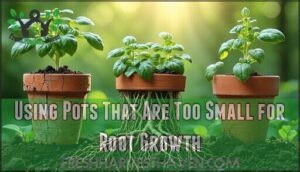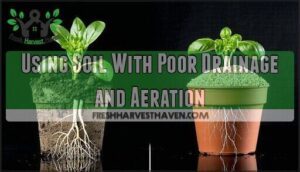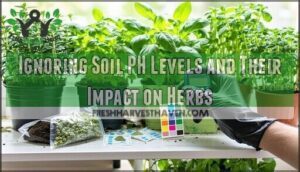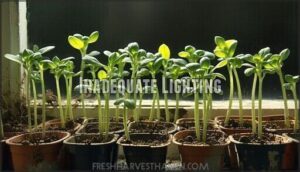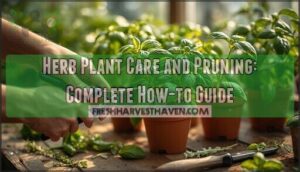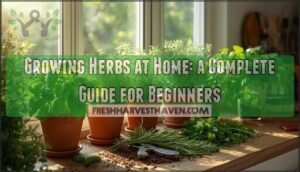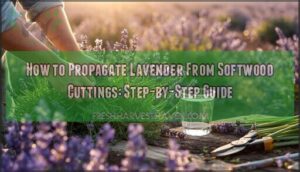This site is supported by our readers. We may earn a commission, at no cost to you, if you purchase through links.
 You’re likely making common mistakes growing herbs indoors that kill even the hardiest plants. Most people choose sun-loving herbs like rosemary for dark kitchens, cram them into tiny pots without drainage, and drown them with good intentions.
You’re likely making common mistakes growing herbs indoors that kill even the hardiest plants. Most people choose sun-loving herbs like rosemary for dark kitchens, cram them into tiny pots without drainage, and drown them with good intentions.
Then there’s the lighting disaster—thinking a windowsill gets enough light when your herbs are basically living in a cave. Poor soil that turns into concrete doesn’t help either.
The watering game becomes a guessing match between bone-dry and swamp-like conditions. These aren’t character flaws; they’re fixable technique issues that even experienced outdoor gardeners stumble over when moving inside, dealing with common mistakes that affect the growth of herbs.
Table Of Contents
- Key Takeaways
- Choosing Wrong Herbs
- Incorrect Pot Sizes
- Wrong Soil Mixtures
- Inadequate Lighting
- Poor Watering Techniques
- Frequently Asked Questions (FAQs)
- Why is it so hard to grow herbs indoors?
- What herbs should not be potted together?
- What are the best conditions for growing herbs indoors?
- How do you keep potted herbs alive indoors?
- How often should I fertilize indoor herbs?
- What temperature range do herbs prefer indoors?
- When should I harvest herbs for best flavor?
- How do I prevent herbs from bolting?
- Can I grow herbs together in containers?
- Conclusion
Key Takeaways
- Choose low-light herbs like mint, chives, and parsley instead of sun-loving varieties like basil and rosemary that need 6-8 hours of direct sunlight daily
- Use properly sized pots with drainage holes – select containers 1.5-2 times larger than the root ball and ensure multiple drainage holes to prevent waterlogged soil
- Create a well-draining soil mix by adding perlite or coarse sand to regular potting mix, and maintain a pH between 6.0-7.0 for optimal nutrient absorption
- Water only when the top inch of soil feels dry – stick your finger 2-3 inches deep to check moisture levels and avoid both overwatering and underwatering mistakes
Choosing Wrong Herbs
Choosing the wrong herbs is often where your indoor garden dreams start to wilt before they even begin.
You might pick high-maintenance varieties that demand more light and care than your home can provide, or select fast-growing herbs that quickly outgrow their containers and crowd out everything else, leading to a situation where your garden dreams start to fail.
Selecting Herbs That Require High Light
Why do so many indoor herb gardens fail? Often, it’s because gardeners choose light-loving herbs without realizing their intense sunlight needs.
High-light herbs like basil, rosemary, and oregano demand six to eight hours of direct sunlight daily—something most indoor spaces can’t provide.
Here are five light-loving herbs that commonly struggle indoors:
- Basil – Requires 6-8 hours of direct sunlight for robust growth
- Rosemary – Needs intense light to develop its signature fragrance
- Oregano – Demands full sun exposure for maximum flavor production
- Sage – Thrives only with consistent, bright direct light
- Thyme – Requires high-intensity lighting to prevent leggy growth
The Fix: Position these herbs at south-facing windows or invest in full-spectrum LED grow lights. Place lights 12-14 inches above plants for 12-14 hours daily.
Monitor for pale leaves or stretched stems—clear signs of insufficient lighting. To maximize growth, consider using well-drained potting mix. Consider grouping light-loving herbs together near your brightest window, and supplement with artificial lighting during shorter winter days.
Picking Herbs That Are Challenging to Grow Indoors
You’re making herb species selection harder than it needs to be.
Rosemary struggles with low indoor humidity, while basil becomes leggy without bright light. Lavender’s the trickiest – it demands full sun and perfect drainage that’s tough to replicate indoors.
Cilantro, dill, and parsley often fail from insufficient light. These difficult species create beginner mistakes that lead to frustration.
Choose easier herb varieties like mint or chives instead. Overwatering, however, can also be fatal to herbs grown indoors, particularly in winter, which is a critical issue to avoid.
Not Considering Herb Growth Rates and Sizes
Overlooking mature size leads to overcrowded disasters in container gardening.
Fast-growing herbs like basil can quickly dominate smaller companions, while space-hungry mint spreads aggressively.
Without considering growth habits and pruning needs, your indoor herb garden becomes a tangled mess.
Plan spacing requirements from the start—your future self will thank you when harvesting!
Incorrect Pot Sizes
Choosing the right pot size makes all the difference between thriving herbs and struggling plants that never reach their potential.
Many gardeners unknowingly sabotage their indoor herb gardens by selecting containers that are too small, lack proper drainage, or don’t provide enough room for healthy root development and plant spread.
Using Pots That Are Too Small for Root Growth
Cramming herb roots into tiny containers is like trying to squeeze into shoes two sizes too small.
When plant roots become rootbound, they can’t absorb nutrients properly, leading to stunted plant size and watering imbalance issues.
Your herbs end up stressed and weak.
Choose pot size that’s 1.5-2 times larger than the root ball, and consider container material impact on growth.
Watch for roots circling the bottom—that’s your cue for repotting.
Not Providing Enough Space for Herbs to Spread
When you’re cramming multiple herbs into a single container, you’re setting them up for failure. Each herb needs adequate space to develop its root system and spread naturally.
Overcrowding leads to competition for nutrients, stunted growth, and increased pest problems. Your plants become rootbound quickly, requiring frequent repotting.
Consider adequate container dimensions for ideal growth. Give each herb its own container or use a much larger pot with proper plant spacing to prevent growth restriction and ensure they have enough room to thrive.
Choosing Pots Without Proper Drainage Holes
Why sacrifice your herbs to waterlogged misery? Poor drainage transforms your indoor herb gardening dreams into soggy nightmares, causing root suffocation and water pooling that kills plants faster than neglect.
Essential drainage solutions for pot selection:
- Terracotta benefits: Clay pots naturally regulate moisture and prevent waterlogging
- Drilling solutions: Add drainage holes to decorative pots using a masonry bit
- Multiple holes: Create 3-4 holes minimum for proper water escape
- Saucer management: Empty collection trays within 30 minutes after watering
- Up-potting frequency: Check drainage holes aren’t blocked when transplanting
Proper drainage holes prevent the indoor herb mistakes that doom most container gardens; similarly, failing to mulch outdoor gardens can lead to moisture loss.
Wrong Soil Mixtures
Your soil choice can make or break your indoor herb garden before you even plant your first seed.
Most gardeners grab whatever potting mix is on sale, but herbs need specific soil conditions to develop their full flavor and avoid common problems like root rot or nutrient deficiencies.
Herbs need these conditions to thrive, and without them, they may not develop their full potential, which can be a result of common problems.
Using Soil With Poor Drainage and Aeration
Dense, clay-like soils create the perfect storm for indoor herb gardening disasters.
Dense soil acts like a prison cell for your herb roots, trapping them in soggy, airless conditions.
You’ll trap roots in waterlogged conditions, causing soil compaction and root suffocation that kills plants quickly.
Garden soil or heavy potting mixes lack proper drainage solutions and aeration methods your herbs desperately need.
Fix this by adding perlite, coarse sand, and compost as soil amendments to improve indoor herb drainage and prevent common indoor herb mistakes.
Many gardeners also source specialized herb amendments for ideal growth.
This approach helps to avoid the pitfalls of indoor herb gardening, ensuring a healthier and more thriving herb garden by using the right drainage solutions.
Not Adding Essential Nutrients and Organic Matter
Poor soil fertility stunts your herb garden’s potential.
Many indoor gardeners skip adding organic compost, creating nutrient-deficient growing environments that cause yellowing leaves and weak growth.
Organic material enriches soil nutrients naturally, while organic fertilizer prevents over-fertilization that burns delicate roots.
Without proper compost, you’re basically starving your plants.
Using green manures can also improve nutrient cycling and is a key part of maintaining healthy soil, which is essential for a thriving herb garden with delicate roots.
Ignoring Soil PH Levels and Their Impact on Herbs
Many indoor gardeners overlook soil pH, yet ideal pH between 6.0-7.0 determines nutrient availability for your herbs.
Ignoring soil acidity creates nutrient lockout, causing yellowing leaves and stunted growth despite proper watering and lighting.
- Testing strips revealing your soil’s true pH numbers
- Lime powder brightening acidic soil for better herb health
- Sulfur amendments lowering alkaline soil naturally
- pH meters providing instant, accurate soil readings
- Herbs thriving with vibrant green leaves in balanced soil
This common mistake affects soil nutrients more than most realize. Regular pH testing prevents indoor herb problems before they start.
Inadequate Lighting
Light is the lifeline of your indoor herb garden, yet it’s where most people stumble.
Without adequate light, your herbs will stretch toward windows like desperate sunbathers, developing weak stems and pale leaves that taste about as flavorful as cardboard.
Not Providing Enough Natural Light for Herbs
Most herbs need six to eight hours of bright sunlight daily, but insufficient light creates weak, leggy growth that kills flavor.
Window placement matters—south-facing spots work best for sunlight requirements.
Light deprivation causes pale leaves and poor indoor herb light conditions. Your herbs stretch toward available light, creating that telltale leggy appearance when sunlight exposure falls short of their needs, resulting in weak and flavor-less herbs due to insufficient light.
Using Incorrect Artificial Lighting Spectrums and Intensities
When you switch to artificial indoor herb light, spectrum impact and intensity levels make or break your harvest.
Wrong LED selection creates weak, flavorless herbs—too much red light produces leggy stems, while excessive blue stunts essential oil production.
Plant placement within 6-12 inches helps guarantee proper light duration effectiveness.
Grow lights requiring 300-600 μmol/m²·s intensity prevent insufficient light issues, meeting your herbs’ light requirements better than inadequate sunlight exposure.
Understanding specific light wavelengths is vital for ideal growth.
Not Supplementing Natural Light With Grow Lights
Even with south-facing windows, insufficient light often hampers indoor herb growth during winter months.
Supplemental lighting using LED grow lights with proper light spectrum guarantees your herbs receive adequate photons year-round.
Position grow lights 6-12 inches above plants, use timer automation for consistent photoperiods, and choose energy-efficient LEDs to minimize consumption while maximizing herb light requirements.
For maximum growth, make certain you’re providing the correct light intensity levels.
Poor Watering Techniques
Water problems kill more indoor herbs than any other issue, yet most gardeners don’t realize they’re making these critical mistakes.
Your indoor herb garden’s success hangs by a thread—one watering mistake away from disaster.
You’re either drowning your herbs with too much love or starving them with neglect, and both approaches lead to the same disappointing result, which is often due to critical mistakes.
Overwatering and Causing Root Rot and Fungal Diseases
You’re drowning your herbs in kindness, but too much water kills faster than drought. Overwatering creates soggy soil that suffocates roots and invites fungal diseases like unwelcome dinner guests.
Here’s your Root Rot Prevention checklist:
- Check soil moisture – Stick your finger 2-3 inches deep before watering
- Ensure proper Drainage Solutions – Use pots with holes and well-draining soil mix
- Improve Soil Aeration – Add perlite or coarse sand to your potting mix
- Adjust Watering Frequency – Water only when topsoil feels dry, not on schedule
Fungal Control starts with smart watering techniques that prevent waterlogged conditions.
Underwatering and Causing Wilting and Stunted Growth
While overwatering kills herbs with soggy conditions, the opposite extreme proves equally damaging.
Underwatering leaves your herbs displaying telltale Wilting Symptoms like droopy leaves and stunted growth.
When soil moisture drops too low, root health suffers dramatically, and dry soil prevents nutrient uptake, causing wilted leaves that signal distress.
You’ll notice reduced Watering Frequency leads to slower development and poor yields from stressed plants.
Not Monitoring Soil Moisture and Adjusting Watering Schedules
Without tracking soil moisture levels and watering frequency, you’re basically flying blind with your herb care.
Check soil dryness by inserting your finger 2-3 inches deep—if it’s dry, it’s time to water.
This simple habit prevents both overwatering and underwatering, protecting against root rot while avoiding wilting signs and ensuring proper drainage importance.
Consider mulching for moisture to further regulate soil conditions, which is crucial for successful vegetable garden watering.
Frequently Asked Questions (FAQs)
Why is it so hard to grow herbs indoors?
You’re fighting three major battles: insufficient light, overwatering, and poor drainage. Most herbs need 6-8 hours of bright light daily, well-draining soil, and careful watering schedules.
What herbs should not be potted together?
Don’t pot aggressive spreaders like mint with slower-growing herbs—it’ll take over. Avoid pairing herbs with different water needs, like drought-loving rosemary with moisture-loving basil.
What are the best conditions for growing herbs indoors?
Like tending a garden greenhouse, you’ll need bright light for 6-8 hours daily, well-draining soil, proper drainage holes, and consistent watering when topsoil feels dry to touch.
How do you keep potted herbs alive indoors?
You’ll need proper drainage, bright light for 6-8 hours daily, and water only when soil’s top inch feels dry. Choose well-draining potting mix and prune regularly to encourage growth.
How often should I fertilize indoor herbs?
Feeding your indoor herbs isn’t rocket science—think of it as giving them a gentle energy boost.
You’ll want to fertilize monthly during growing season with diluted liquid fertilizer, then back off in winter when growth slows.
What temperature range do herbs prefer indoors?
Most herbs thrive in temperatures between 65-75°F during the day and 55-65°F at night.
You’ll want to avoid cold drafts, heat vents, and sudden temperature swings that stress plants and reduce their flavor.
When should I harvest herbs for best flavor?
Harvest herbs in the morning after dew dries but before midday heat. Pick young, tender leaves regularly to encourage growth and maintain peak flavor concentration throughout the growing season.
How do I prevent herbs from bolting?
Coincidentally, just as you’re wondering about bolting, regular harvesting is your best defense.
Pinch flowers immediately when they appear, harvest frequently, and keep plants cool to prevent herbs from rushing to seed.
Can I grow herbs together in containers?
You can grow herbs together, but give each plant adequate space in large containers or separate pots.
Make certain all herbs get uniform light and water, and choose companions with similar growing requirements for best results, ensuring each plant receives the necessary conditions to thrive, which includes giving them uniform light.
Conclusion
Mastering indoor herb gardening isn’t rocket science once you’ve conquered these common mistakes growing herbs indoors.
You’ll transform your windowsill into a thriving herb paradise by choosing the right varieties, providing proper containers with drainage, using quality potting mix, ensuring adequate lighting, and establishing consistent watering routines.
Start with beginner-friendly herbs like basil and mint, then expand your collection as your confidence grows.
Your future self will thank you for these simple adjustments to create a successful indoor herb garden, allowing you to enjoy the benefits of growing herbs indoors.
- https://web.extension.illinois.edu/containergardening/choosing_drainage.cfm
- https://extension.unh.edu/blog/2020/01/what-best-soil-potted-plants
- https://herbsathome.co/your-guide-to-the-best-indoor-lighting-for-growing-herbs/
- https://acornhorticulture.com/growing-herbs-and-medicinal-plants-in-grow-tents-a-comprehensive-guide/
- https://www.extension.iastate.edu/news/yard-and-garden-growing-herbs-indoors

